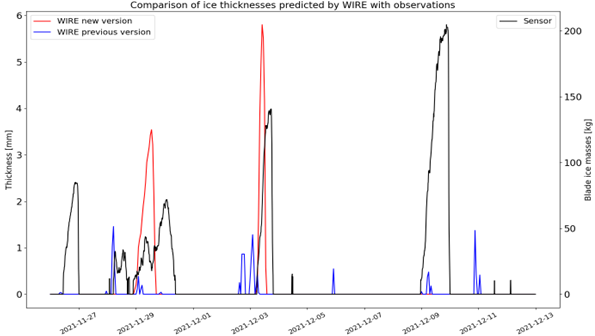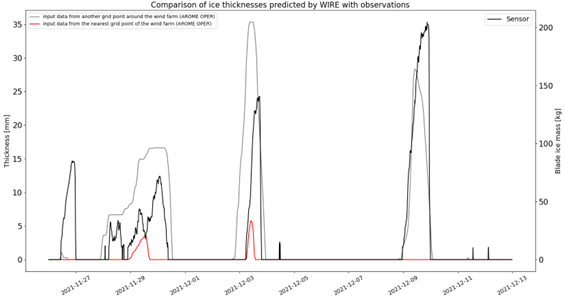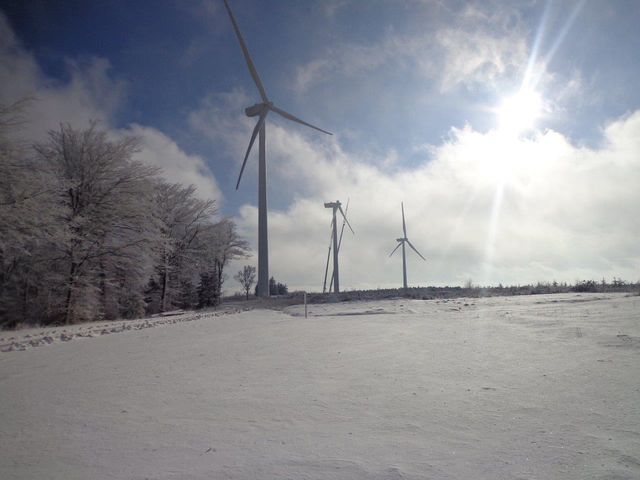Since October 2021, VALEMO has been involved in a CIFRE thesis project, in collaboration with the CNRM (Centre National de Recherches Météorologiques) and Météo France, to continue improving an icing forecasting model (WIRE) on wind turbine blades. The aim of this partnership is to obtain an operational tool for our control centre for the operation of wind farms. The work in this thesis focuses on three main areas in order to improve the whole icing risk prediction chain for wind farm management:
- The first concerns the performance of the AROME numerical weather prediction (NWP) model, whose parameters are used as input data by WIRE.
- Secondly, the modelling of the icing phenomenon and the implementation of a melting module in the operational version of WIRE.
- A third area of research concerns the taking into account of uncertainties through the use of probabilistic forecasts.
Halfway through this project, our PhD student has focused on the first two areas.
The AROME model is the fine-grid NWP model that has been in operational use at Météo-France since 2008. The model has a grid of 1.3 km and produces five forecasts a day over mainland France, helping to improve forecasts of the day’s and the next day’s weather phenomena (with forecasting timescales of up to 48 hours). Most NWP models have a significant bias when it comes to forecasting icing and tend to freeze clouds too easily. For example, AROME only predicts totally icy clouds below -20°C and has difficulty in accurately representing liquid water at sub-zero temperatures. However, supercooled liquid water is an important input parameter in the icing forecast model, since this parameter controls the accretion of ice on the blades. Therefore, improving the representation of supercooled liquid water in NWP models is both interesting and necessary to improve the WIRE results. In this first area, various sensitivity tests were first carried out to determine the processes that have the greatest impact on the creation and consumption of supercooled liquid water in AROME. Following these tests, three parameterisations combining several process modifications were selected. Simulations were carried out and compared with data from an airborne measurement campaign that took place in the United States in 2019. This comparative study showed that one of the parameterisations made it possible to increase the quantities of supercooled liquid water simulated by the model while avoiding degrading the overall performance of the meteorological model. However, further analysis by the Météo France teams will be required before these modifications can be implemented in a future version of AROME.
With regard to the second axis, modifications have been made to the first version of WIRE dedicated to the wind energy sector (a version developed during a course supervised by VALEMO in 2020). The main improvement made to the icing forecasting model is the addition of a melting module to simulate the duration of the forecast icing episode and thus have information on the moment when the icing has completely melted so that the turbines can be restarted in complete safety. In addition, the initial accretion module was reworked to adapt certain parameters to the modelling of a rotating wind turbine blade. In order to validate these new features, observation data from icing sensors installed on wind turbine blades were used. As shown in Figure 1, the changes made to WIRE reduced false alarms and increased the icing thickness predicted by the model. However, the detection and duration of the episodes were poorly represented. Another approach was therefore considered, using input data that were more representative of the site studied, particularly in terms of altitude. Thanks to this new approach (Figure 2), WIRE obtains better results both in terms of event detection and the duration of icing events predicted by the model. Thanks to the work carried out on the accretion and melting part, the WIRE forecasts now provide information that can be used in an operational context.
The end of our PhD student’s thesis will be devoted to taking into account the uncertainties present in the meteorological models and in the icing forecast model in order to assess the contribution of probabilistic forecasts and their added value for forecasting icing episodes on our wind farms.



